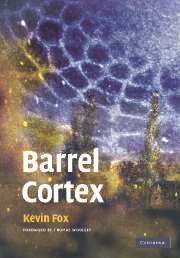Book contents
- Frontmatter
- Contents
- Foreword
- Preface
- Acknowledgements
- Abbreviations
- 1 Introduction to the barrel cortex
- 2 Anatomical pathways
- 3 Cellular and synaptic organization of the barrel cortex
- 4 Development of barrel cortex
- 5 Sensory physiology
- 6 Synaptic plasticity of barrel cortex
- 7 Experience-dependent plasticity
- 8 New and emerging fields in barrel cortex research
- References
- Index
- Plate section
1 - Introduction to the barrel cortex
Published online by Cambridge University Press: 17 August 2009
- Frontmatter
- Contents
- Foreword
- Preface
- Acknowledgements
- Abbreviations
- 1 Introduction to the barrel cortex
- 2 Anatomical pathways
- 3 Cellular and synaptic organization of the barrel cortex
- 4 Development of barrel cortex
- 5 Sensory physiology
- 6 Synaptic plasticity of barrel cortex
- 7 Experience-dependent plasticity
- 8 New and emerging fields in barrel cortex research
- References
- Index
- Plate section
Summary
Introduction
The barrel cortex is a remarkable structure. Its form has captured the imagination of researchers for decades and its versatility has ensured that it finds a place in each new wave of neuroscience research. Since its discovery by Woolsey and Van der Loos in the early 1970s, researchers have used barrel cortex to study some of the most pressing questions in neuroscience. How does the cortex develop? How does active touch work? What makes neurons plastic? In each case, the value of the barrel cortex has been to help neuroscientists to relate structure with function through its unique and easily defined form.
In order to understand how these questions are being addressed currently, it is useful to understand some of the basic structural and functional features of the barrel cortex. The first three chapters of this book address some of the fundamental anatomy and physiology of the barrel cortex. For the expert in the field, most of what is written in these chapters will probably be quite familiar but will hopefully still serve as a useful reference to the original studies. While most of the original anatomical studies span the 1970s and 1980s, new neuroanatomical findings are still being described into the current century. Curiously, a review of this anatomical literature has not previously been written. For those less familiar with barrel cortex, the anatomical pathways linking the periphery to barrel cortex are described in Chapter 2 along with the intracortical connections, the study of which, at the time of writing, is still an active area of research.
Information
- Type
- Chapter
- Information
- Barrel Cortex , pp. 1 - 13Publisher: Cambridge University PressPrint publication year: 2008
Accessibility standard: Unknown
Why this information is here
This section outlines the accessibility features of this content - including support for screen readers, full keyboard navigation and high-contrast display options. This may not be relevant for you.Accessibility Information
- 2
- Cited by
